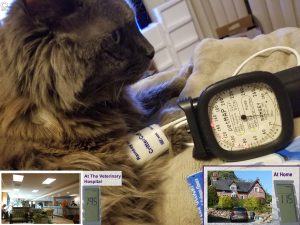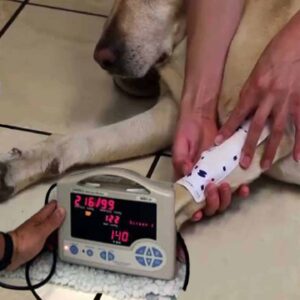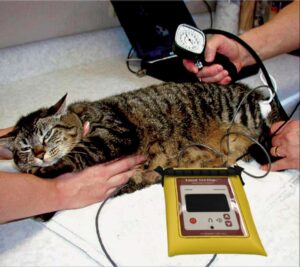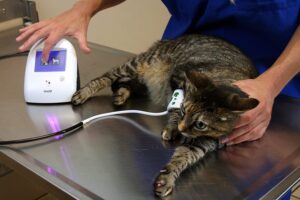 Why Is My Dog Or Cat’s Blood Pressure High or Low?
Why Is My Dog Or Cat’s Blood Pressure High or Low?
How Accurate Are My Cat Or Dog’s Blood Pressure Readings Taken At My Animal Hospital?
Ron Hines DVM PhD
The vast majority of cats, and quite a few dogs, are homebodies that do not enjoy their visits to their local animal hospital any more than you enjoy your visits to your hospital. “Fear-Free” marketing not withstanding, your pet’s memories of prior visits and its tendency to be suspicious of new situations have physiological consequences. (read here) So does simple excitement. Because of those factors, the accuracy of your cat or your dog’s blood pressure reading at your local animal hospital is always in doubt. (read here, here & here) I do not know of any specific cat breeds that are more prone to higher blood pressure than others, although Siamese-type cats have been mentioned. As I mentioned, one study found the Birman breed of cat to have lower readings than the other breeds they tested. (read here) But sighthounds such as deerhounds and greyhounds are known to have naturally higher blood pressure than most other dog breeds (~10-20 mm Hg higher). Mellow breeds, such as Labrador retrievers and beagles, have been reported to have lower than average blood pressure readings as well. There is a gradual, moderate, increase in average blood pressure readings in both dogs and cats that is related to aging (in cats perhaps 1.5 mm Hg/year when >9yrs?). (read here) The two most common causes of high blood pressure in cats are thought to be hyperthyroidism and chronic kidney disease. Less is known about the causes of elevated blood pressure in dogs. Uremic dogs, with only a small functional portion of their kidneys remaining, often have elevated blood pressure. But if their loss of kidney function is the cause or the result of their high blood pressure remains unknown.
That is why I have a suggestion. It would be wise to have a friendly, unhurried, mellow house call veterinarian check your pet’s blood pressure several times while your pet is relaxing at home. (read here). That visit could be for other purposes. Just be sure the vet brings her or his BP monitor along, chats with you for a while, offers your pet treats, and then have the readings taken before other procedures begin. I think that it’s worth the effort before agreeing to place your cat or your dog on lifelong blood pressure-lowering medications.
What Medications Do Veterinarians Dispense To Reduce Confirmed High Blood Pressure In My Pet?
ACE inhibitors such as enalapril or benazepril are often utilized. Calcium channel blockers such as amlodipine are also effective. ARBs such as telmisartan or losartan have been used as well. Alpha blockers such as phenoxybenzamine or prazosin and beta-blockers such as atenolol are also dispensed by veterinarians to lower blood pressure. These are all drugs that are used successfully for a number of health issues that cats and dogs face, not only system-wide hypertension. For your dog, enalapril and benazepril are probably the most likely medications to be dispensed, perhaps in combination with telmisartan. Using lower doses of two medications that work in different ways allows veterinarians to keep the dose of each lower. That might reduce side effects. For cats, amlodipine has been the most common medication dispensed. (read here)
What Is A Normal Cat Or Dog’s Blood Pressure Reading?
Veterinarians have not yet discovered a safe and accurate way to measure your dog or your cat’s diastolic blood pressure. That is the lower of the two numbers that your physician reports to you. It represents your blood pressure between heart beats. However, other than in cases of heart failure, knowing your pet’s higher number, its systolic pressure, is all that your veterinarian needs to know.
If you do a Google search for that question, you will see that there is much disagreement as to what “normal” systolic blood pressure (the higher number) should be in your dog or your cat. But it is probably safe to say that it should range between 110 and 160 mmHg in a dog, although some veterinarians would consider 160 to already be problematic. When measured experimentally by actually inserting a catheter into the artery of 8 healthy dogs (the most accurate way), readings ranged from 114 to 194 mmHg. (ask me for Stepien1999). However, 8 dogs are not enough to make a blanket statement.
The normal systolic BP (the higher number) in relaxed cats is thought to range from 120 to 140 mmHg with an average of about 125. (ask me for Taylor2017.pdf) In one study, Birman cats had lower blood pressure readings than the other cat breeds studied. (read here)

There is still a lot of confusion regarding the accuracy of veterinary blood pressure monitors in general and in the comparative accuracy of the two major types of machines, oscillometric and doppler. In a 2005 study of UK cats, oscillometric machines produced lower blood pressure readings than doppler-based machines. (read here) While another 2021 UK study found that oscillometric machines produced higher reading than doppler-based machines. So what is “normal” doesn’t only depend on your cat or your dog. It also depends on the brand of BP measuring device used, where the measurement was taken, who took the measurement and whose opinion of “normal” is relied upon.
Is There More Than One Form of High Blood Pressure In Dogs And Cats?
Yes, there are two.
This article is about high blood pressure when it affects the blood of your pet’s entire body. That is called systemic or arterial hypertension. When high blood pressure affects only your pet’s lungs and the heart’s blood vessels that lead to its lungs, it is called pulmonary hypertension. Pulmonary hypertension is diagnosed and treated in different ways. The most common medication veterinarians dispense for that problem is sildenafil (Viagra®). Read about the most common cause of pulmonary hypertension in dogs and cats here.
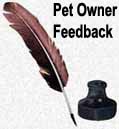 Let me know your thoughts on this subject here
Let me know your thoughts on this subject here
The Rest Of This Article Is Contributed By Readers:
Owner updates in green My comments in purple
*************************
January 5, 2020
From Neal *** Subject: Blood Pressure Reading Was Wrong By 80 Points Due To Fear
Ron: You know that my cat, Gilbert, is taking amlodipine for his “high blood pressure”. I’m buying from Wedgwood in New Jersey. He takes 0.625 mg in the morning plus 0.625 mg in the evening. Gilbert’s blood pressure tests at the vet’s office in Las Vegas is running 180 – 210. Dr. M*** is using a petMAP™ classic to measure Gilbert’s blood pressure. I had a house call vet come to my house as you suggested. She scared him and held him tightly. So, I bought the same machine that Dr. M** has. It cost me $1,595.00. I wrote out detailed instructions on testing if you would like them and I attached their instruction manual. If Gilbert shakes, that does affect his reading. When I take his blood pressure readings at home they are about 80 points lower. Perhaps your readers could buy and share one if nearby each other, or in a club, or a loaner or rental. It took me two hours to learn and practice. I was shocked and believe in avoiding over treatment. Maybe Gilbert doesn’t need amlodipine at all.
Happy New Year to Gloria and you, N***
January 10, 2020 Ron: I stopped the amlodipine Wednesday. and Gilbert has remained at 135 for the past 2 days with 7 tests in the morning and evening. I’ll check it daily. Dr. R., my new vet, agrees that an 80 point difference (elevation) in blood pressure readings is common for cats when taken at the veterinary hospital. Regrettable for that major error, but veterinarians don’t currently have a way to resolve this issue. I suggested that veterinarians rent our accurate blood pressure meters to their pet-owning clients or set up a take-home loan program, so pet owners could take the meters home and test their pet’s BP in a less stressful setting. Best regards to Gloria and you. N***
You are on the Vetspace animal health website
Visiting the products that you see displayed on this website help pay the cost of keeping these articles on the Internet.

